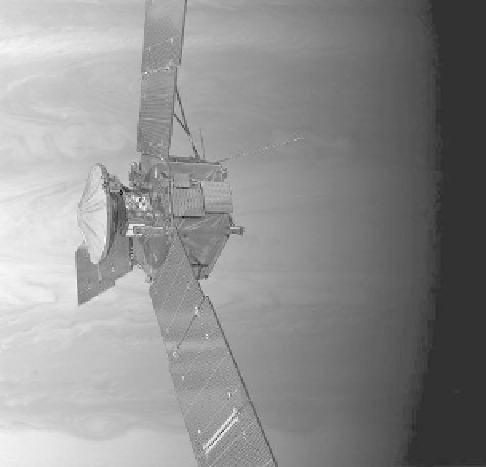Geology Reference
In-Depth Information
placed in Mars orbit in the fall of 2014. The mission will
focus on Mars
'
upper atmosphere and interactions with
the Sun to determine the loss of volatiles such as carbon
dioxide and water. The results will provide unprece-
dented insight into the history of the atmosphere and
climate, especially as related to the planet
s habitability.
The scienti
c payload includes instruments to chara-
cterize the solar wind, Mars
'
ionosphere, and the atmos-
pheric composition. The MAVEN spacecraft is scheduled
to operate for one Earth year, or about one-half of a
Mars year.
The more distant future of Mars exploration is less
certain. NASA and the ESA have recently been studying
projects leading to the eventual return of samples from
Mars to Earth. The return of martian samples from a site of
known geologic context has been a high priority in plan-
etary exploration for many decades. But such a mission is
not so easy, and will not be accomplished in a single step.
Rather, the
first step would be to send a large rover,
launched possibly in 2018. In addition to conducting
in situ experiments focused on astrobiology and geology,
this mission would
“
cache
”
(store) samples for return to
Earth in the 2020s using a system yet to be designed.
Current plans involve lift-off of the samples from Mars,
with a small capsule being placed in orbit around Mars.
This would later be captured by a separate spacecraft for
return to Earth.
Exploration of the outer Solar System continues, but not
at the same pace as for Mars and the inner Solar System.
Currently in
flight are Cassini (
Chapter 9
), scheduled to
continue orbiting Saturn until September 2017, New
Horizons, which will execute a
flyby of Pluto in 2015, and
Juno,whichwaslaunchedin2011andisscheduledtobegin
mission, it will complete 33 orbits and then de-orbit to
plunge into Jupiter
'
Figure 11.3. An artist
s rendition of the Juno spacecraft in operation
around Jupiter in 2016.
'
Many of the missions to these objects described in
Chapter 1
continue to return new data, including infor-
mation relevant to planetary geology. For example, Dawn
returned close-up images of asteroid Vesta (
Fig. 11.4
) and
will be programmed to leave this object to reach asteroid
Ceres in 2015. In addition to these missions, the ESA
'
s
Rosetta spacecraft was launched in 2004 and is scheduled
to rendezvous with Comet 67P/Churyumov-Gerasimenko
in 2014 to begin a detailed analysis of this 4 km object.
The spacecraft will orbit the comet as it approaches the
Sun to collect data on processes in and on the icy nucleus
as it is warmed by the Sun. A small lander will be released
from the orbiter to make in situ measurements of the
comet
'
s composition and physical properties, as well as
to image its surface.
In 2016, the OSIRIS-REx (Origins
-
Spectral Interpretation
-
Resource Identi
cation
-
Security
-
Regolith Explorer) space-
craft will be launched to reach the near-Earth asteroid
1999RQ36 in 2020. In this mission, led by planetary scientist
Dante Lauretta, after six months of intensive study and surface
mapping, the spacecraft will approach a site on the asteroid
selected by the science team and extend a robotic arm to collect
a small sample. The samples will be returned to Earth in 2023
and will enable comparisons of asteroid materials with com-
etary material that was collected from Comet Wild 2 and
returned to Earth by the Stardust spacecraft.
s dense atmosphere, ending the mission.
Juno
'
sscienti
c objectives are to determine the amount
of water in the atmosphere, measure the composition, tem-
perature, and cloud motions in the atmosphere, and gain
insight into Jupiter
'
s magnetosphere and gravity
fields.
Collectively, the anticipated data will enable new perspec-
tives on the origin and evolution of the giant planets. While
not providing direct data on the geology of the satellites, the
new data will be relevant to the overall evolution of the outer
planets and their satellites.
Comets and asteroids are important objects for under-
standing the origin and evolution of the Solar System.
'



